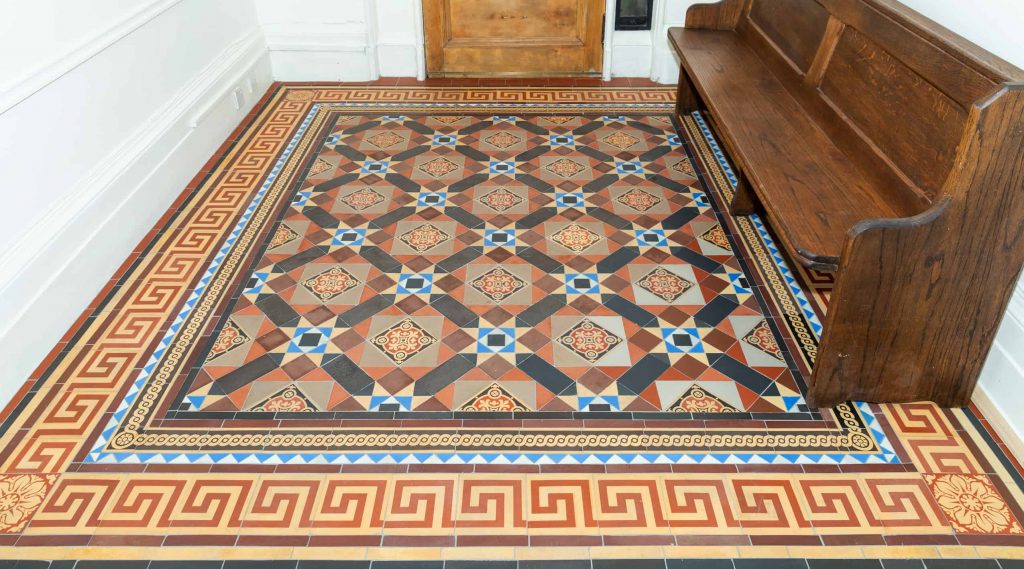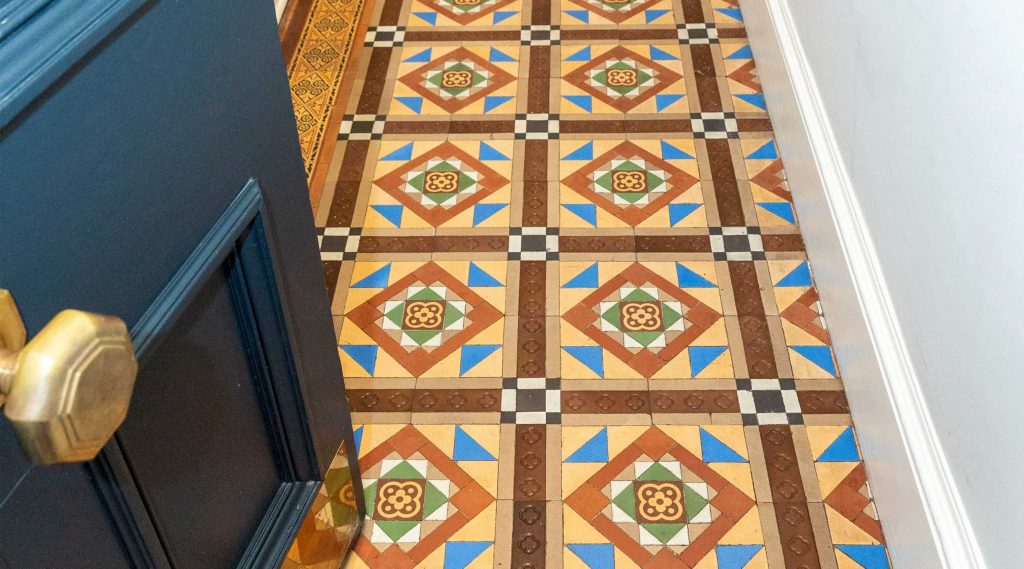Mosaic tile installation looks stunning when done right, intricate patterns, visual texture, and a bespoke finish. But in practice, mosaic tiles bring unique challenges and failure points that many property owners or even general tilers underestimate.
At Were Tiling, servicing Glasgow, Edinburgh, and Newcastle, we often encounter clients who want mosaic tile work and those needing Victorian tile restoration or Victorian mosaic tiles repairs. Understanding the pitfalls up front helps you make informed decisions.
Here’s an in-depth look at “what is the problem with mosaic tiles?” — the risks, root causes, and how to prevent them (or work with an expert).

Why Mosaic Tile Installation Is More Demanding?
Before diving into the problems, it helps to understand why mosaic tile installation is inherently more demanding than conventional tiling:
- Many grout lines: Because mosaic tiles consist of small pieces, each joint must be carefully grouted and sealed, increasing labour and risk of defects.
- Precision alignment: Small errors in alignment or spacing are magnified visually.
- Mesh backing intricacies: Many mosaics come pre-mounted on mesh or paper, which introduces its own complications.
- Cutting and trimming: You often need to cut individual mosaic bits or sheets, which is more time-consuming than cutting standard large tiles.
- Substrate sensitivity: Any irregularities or movement in the substrate show up more readily with mosaics.
- Adhesive compatibility: The bond between tile, adhesive, and backing can fail if mismatched.
Let’s explore the common failure points you may face.
Common Problems with Mosaic Tile Installation (and Why They Happen)
Tile Delamination, Loose or Falling Pieces
One of the most frequent complaints is mosaic tiles detaching from the mesh or adhesive and falling out over time.
- Mesh-mounted mosaics often use a water-soluble adhesive to stick the tile bits to the mesh. When cut using a wet saw, that glue can dissolve, causing individual pieces to come loose. (TileLetter, 2024).
- Excessive glue between mosaic and mesh can act as a bond breaker, preventing the mortar from bonding to the tile’s face (instead bonding to glue), weakening the overall bond. (TileLetter, 2024).
- Moisture infiltration in wet areas (e.g. showers, exterior facades) can gradually degrade adhesives or grout, causing loosening. (TileLetter, 2024).
When tiles come loose, repairs are often laborious: you may have to re-adhere individual pieces or even remove and replace entire sections.
Irregular Spacing and Misalignment
Because mosaic tiles are small and are often pre-mounted in “sheets,” inconsistencies in spacing or alignment can become pronounced:
- Some sheets have tiles too tightly packed, others too loose, forcing the installer to cut or rework sections. Tilers have reported cutting off up to 30% of a sheet to make it workable. (TilersForums, 2024).
- Misaligned lateral joints (crooked mosaic strips) require adjustments, and can be hard to correct without compromising pattern continuity.(TileLetter, 2024).
- If mosaic sheets don’t conform to ANSI or industry tolerance of joint widths, you may get “zigzag” grout or visual distortion. (TileLetter, 2024).
These issues are labour-intensive to fix during installation and can cause visible irregularities in the finished surface.
Uneven Surface / Lippage
Because mosaics are small, any substrate unevenness shows through. Even 1–2 mm dips can cause “lippage” (one tile higher than the next) (Archipro, 2025).
Common causes include:
- Inconsistent adhesive thickness or trowel technique.
- Using mosaics beside thicker tiles without compensating adhesive build-up (Tile Mountain, 2025).
- Any unevenness will be visible in a pattern tile surface, particularly in low-angle lighting.
Grout Staining, Discoloration & Maintenance
Mosaics have more grout lines per area than standard tiles, meaning more maintenance.
- Larger grout surface area increases dirt absorption and staining (BHG, 2024).
- Over-wet cleaning or wrong grout type can cause discolouration or cracking (BHG, 2024).
- Without sealing, mould may develop in bathrooms or kitchens.
For example, a mosaic bathroom floor may look pristine at first, but the grout can yellow or get mouldy where cleaning is difficult.
Cracking or Breakage
Because mosaic pieces are small and brittle (especially with glass or stone mosaics), they can crack under pressure if not fully supported:
- If adhesive doesn’t fully back each piece or avoid voids, small tiles may flex or crack over time.
- Substrate movement or flexing (e.g. a wooden floor with insufficient rigidity) can stress grout lines or edges, leading to chips or fracturing.
- Sharp cuts, overhandling, or poor handling during installation contribute to breakage.
Complexity in Cutting & Fitting
In many installations, you need to cut mosaic pieces around curved edges, fixtures, or odd corners:
- Mesh backing can delaminate when cut with a wet saw, forcing you to reassemble mosaic bits manually. (TileLetter, 2024).
- Small bits often require tile nippers, precision tools, and patience.
- For feature or decorative mosaics (e.g. Victorian mosaic tiles, black and white Victorian mosaics, or Georgian/Victorian pattern mosaics), matching pattern continuity across cuts is challenging.

Mosaic Tile Installation: How to Prevent These Problems
The good news is that all these risks can be mitigated, especially when you work with a specialist tiling company like Were Tiling. Here are best practices and tips to avoid failures:
Rigorous Surface Preparation
- Ensure substrate is level, rigid, stable, and clean (no dust, oil, loose material).
- Use self-levelling compounds or screeds if necessary to eliminate dips or high spots.
- Allow correct curing times on new screeds or plaster (e.g. 28 days for cement, or lower humidity thresholds for anhydrite). (Trend Group, 2024).
- Use primers, waterproofing membranes, or decoupling layers where needed (especially in wet areas).
Choose the Right Mosaic & Backing System
- Prefer face-mounted or dot-mounted mosaics rather than mesh with weak glue. Face-mounted systems allow full mortar contact.
(TileLetter, 2024). - Avoid mosaics with water-soluble adhesives in moist or vertical environments.
- Use high-quality mosaic sheets with consistent tolerances and verified alignment.
- For decorative Victorian mosaic installations (e.g. Victorian mosaic floor tiles), choose tiles made for floor load, rated for foot traffic and with consistent pattern quality.
When Mosaic Tiles and Victorian Tile Restoration Intersect
If you’re dealing with Victorian tiles (interior hallways, floors, porches), the complications multiply further:
- Colour matching & pattern continuity: Victorian tile floors use specific colour palettes (black, white, green, border, hearth, etc.). Matching replacements or reproductions involves careful sourcing.
- Fragile historic tiles: Original tiles may have wear, cracking, craze lines, or missing pieces. Restoration requires delicate repairs, patching, and seamless integration with new ones.
- Grout & sealing compatibility: Historic tiles may respond differently to modern grout or sealers, so compatibility and breathability matter.
- Substrate stability under older floors: Victorian era subfloors may be uneven, weak, or have movement, demanding extra reinforcement before reusing mosaic / patterned tiles.
- Client expectations: Homeowners may seek Victorian mosaic tiles, or Victorian tile restoration services, and expect that the repair is invisible and long lasting.
At Were Tiling, we regularly take on jobs like Victorian tile restoration Glasgow, Victorian tile repair Edinburgh, and Victorian tile restoration Newcastle. Our approach ensures the restored mosaic floors and borders match seamlessly and resist the issues above.
Use Proper Adhesive & Application Techniques
- Use thin-set mortar (or epoxy mortar in wet zones) suited to the tile and substrate.
- Comb adhesive using the correct notched trowel, ensuring full “buttering” of the mosaic backing.
- Use “back-buttering” of the tile where necessary (i.e., apply a thin coat of mortar to the back).
- Work in small sections so mortar does not skin over before mosaics are laid.
- Press the mosaic sheet into the adhesive with a firm, even pressure, ideally using a rubber float or plywood block to ensure full seating.
Careful Grouting & Sealing
- Use the appropriate grout type (unsanded, fine, epoxy) depending on tile angular tolerances and joint width.
- Grout diagonally, ensuring full fill of each joint.
- Wait appropriate time before wiping down to avoid pulling grout from joints.
- Seal grout (and in some cases tile) with quality sealants to reduce moisture penetration and staining.
- Re-seal periodically (maintenance schedule) especially for high-traffic or wet zones.
Mock-ups and Pre-visualisation
- Run a small “mock up” section before full installation to check pattern, grout colour, alignment, and aesthetic.
- In restoration projects (e.g. Victorian floor tile restoration), this helps to compare original Victorian tiles (black & white Victorian tiles, Victorian border tiles, etc.) and make sure the new blends well.
Hire Skilled, Specialist Installers
Given the extra precision required, working with tilers experienced in mosaic tile installation and Victorian tile restoration is often essential. In Scotland (Glasgow, Edinburgh, Newcastle), a specialist team ensures fewer installation errors, better durability, and more aesthetic success.
How Much Does Mosaic Tile Installation Cost?
Because mosaic installation is more labour-intensive and risk-prone, the cost is typically higher than standard tiling. Key cost drivers include:
- Size and complexity of the area
- Pattern complexity (e.g. custom shapes, border work, curves)
- Substrate preparation (levelling, repair, waterproofing)
- Tile quality and type (glass, natural stone, ceramic, heritage replication)
- Grout type, sealing, and maintenance
- Accessibility, location (floor, wall, wet zone)
In the UK, general tile installation costs may start from ~£100–£130 per m² or more (labour + materials) depending on region and complexity. For mosaic, you should expect a significant premium. In restoration of heritage floors, additional costs arise from matching old tiles, delicate removal, and custom repairs.
If you’re looking for tile restoration cost, especially for mosaic tile restoration, we provide transparent quotes with breakdowns.

Is Mosaic Tile Installation Worth It?
Given the added risks, you may wonder: should I just choose large format tile instead? The answer depends:
Benefits of mosaic installation
- Stunning visual impact, intricate patterns, ability to follow curves or transitions
- Fine detail and aesthetic styles (especially heritage or decorative work)
- Better for certain wet zones (e.g. shower floors) where multiple small pieces follow drainage slopes more easily
Trade-offs & extra care
- More maintenance (especially on grout)
- Higher skill required, even competent tilers may not deliver a flawless mosaic job
- Greater risk of failure if shortcuts are taken
If aesthetics and pattern are critical (e.g. in heritage restoration, decorative zones, or bespoke interiors), mosaic is often justified. But always work with a specialist who understands and can mitigate the risks.
Were Tiling — Your Local Mosaic & Victorian Tile Experts
Serving Glasgow, Edinburgh, and Newcastle, Were Tiling provides:
- Expert mosaic & Victorian tile restoration across Glasgow, Edinburgh, and Newcastle
- Victorian floor restoration and tile repair near me
- Grout restoration and tile cleaning professional services
- Outdoor tile restoration and kitchen tile replacement
Conclusion
Mosaic tile installation is a technical art, with precision, patience, and skill, it becomes a masterpiece rather than a maintenance headache. Combine that with heritage expertise, and you have a long-lasting surface that honours tradition and design.
If you’re planning a new mosaic project or need Victorian tile restoration near me, contact Were Tiling today. We’ll help you achieve flawless, lasting results, from installation to restoration.
FAQs ( Frequently Asked Questions )
- Are mosaic tiles hard to install?
Yes. They require high precision and correct adhesive selection. - Can mosaic tiles be used on floors?
Yes, absolutely, many mosaic floors (including Victorian mosaic floor tiles) exist in wet and dry zones. The key is choosing tiles rated for foot traffic and ensuring solid mortar backing and grout. - How to maintain Victorian or mosaic floors?
Use a pH-neutral tile cleaner, avoid harsh acids, re-seal grout periodically, and promptly attend to stains or wear spots. - How much does Victorian tile restoration cost?
Costs vary widely depending on area, complexity, tile match, substrate repair, etc. We provide tailored quotes, contact us for a quote specific to Glasgow, Edinburgh or Newcastle. - Can I DIY mosaic tile installation?
While feasible for experienced DIYers in small areas, the risk of misalignment, adhesive issues, grout problems, and unevenness is high. For quality, longevity, and aesthetic work (especially with heritage or pattern tiles), a professional is strongly recommended.

References:
Archipro. (2025). Are mosaic tiles hard to install? Retrieved from https://archipro.com.au/article/are-mosaic-tiles-hard-to-install
TileLetter. (2024). Technical challenges tile installers wish manufacturers understood. Retrieved from https://www.tileletter.com/technical-challenges-tile-installers-wish-manufacturers-understood
TilersForums. (2024). Mosaic tile spacing problems. Retrieved from https://www.tilersforums.com/threads/mosaic-tile-spacing-problems.4424
Tile Mountain. (2025). How to install a mosaic tile border. Retrieved from https://www.tilemountain.co.uk/blog/install-mosaic-tile-border
Better Homes & Gardens (BHG). (2024). Common grouting mistakes and how to fix them. Retrieved from https://www.bhg.com/grouting-mistakes-8678585
Trend Group. (2024). Mosaic installation guide. Retrieved from https://trend-group.com/install-mosaic


